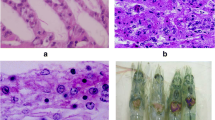Abstract
Shrimp is an important commodity in international trade accounting for 15 % in terms of value of internationally traded seafood products which reached $102.00 billion in 2008. Aquaculture contributes to over 50 % of global shrimp production. One of the major constraints faced by shrimp aquaculture is the loss due to viral diseases like white spot syndrome, yellow head disease, and Taura syndrome. There are several examples of global spread of shrimp diseases due to importation of live shrimp for aquaculture. Though millions of tonnes of frozen or processed shrimp have been traded internationally during the last two decades despite prevalence of viral diseases in shrimp producing areas in Asia and the Americas, there is no evidence of diseases having been transmitted through shrimp imported for human consumption. The guidelines developed by the World Animal Health Organisation for movement of live animals for aquaculture, frozen crustaceans for human consumption, and the regulations implemented by some shrimp importing regions in the world are reviewed.










Similar content being viewed by others
References
Biosecurity Australia. Generic import risk analysis report for prawns and prawn products. Biosecurity Australia, Canberra, Australia. 2009; http://www.daff.gov.au/ba/ira/final-animal/prawns. Accessed Jan 2012.
Cedano-Thomas Y, de la Rosa-Velez J, Bonami JR, Vargas-Albores F. Gene expression kinetics of the yellow head virus in experimentally infected Litopenaeus vannamei. Aquacult Res. 2010;41:1432–43.
Chakraborty A, Otta SK, Joseph B, Sanath K, Hossain MS, Karunasagar I, Venugopal MN, Karunasagar I. Prevalence of white spot syndrome virus (WSSV) in wild crustaceans along the coast of India. Curr Sci. 2002;82:1392–97.
Corbel V, Zuprizal, Shi Z, Huang C, Sumartono, Arcier JM, Bonami JR. Experimental infection of European crustaceans with white spot syndrome virus (WSSV). J Fish Dis. 2001;24:377–82.
Escabedo-Bonilla CM, Alday-Sanz V, Wille M, Sorgeloos P, Pensaert MB, Nauwynck HJ. A review on the morphology, molecular characterization, morphogenesis and pathogenesis of white spot syndrome virus. J Fish Dis. 2008;31:1–18.
Flegel TW. Review of disease transmission risks from prawn products exported for human consumption. Aquaculture. 2009;290:179–89.
FAO. The State of the World Fisheries and Aquaculture 2010. Rome: FAO; 2010. p. 197.
Hossain MS, Chakraborty A, Joseph B, Otta SK, Karunasagar I, Karunasagar I. Detection of new host for white spot syndrome virus of shrimp using nested polymerase chain reaction. Aquaculture. 2001;198:1–11.
Koyama T, Asakawa S, Katagiri T, Shimizu A, Fagutano FF, Mavichak R, Santos MD, Fuji K, Sakamoto T, Kitakado T, Kondo H, Shimizu N, Aoki T, Hirono I. Hyper-expansion of large DNA segments in the genome of kuruma shrimp Marsupenaeus japonicus. BMC Genomics. 2010;11:141.
Lightner DV. Virus diseases of farmed shrimp in the Western Hemisphere (the Americas): a review. J Invert Pathol. 2011;106:110–30.
Lightner DV, Redman RM, Poulos BT, Nunan LM, Mari JL, Hasson KW. Risk of spread of penaeid shrimp viruses in the Americas by the international movement of live and frozen shrimp. Rev Sci Tech-Off Int Epizoot. 1997;16:146–60.
Lo CF, Ho CH, Peng SE, Chen CH, Hsu HC, Chiu YL, Chang CF, Liu KF, Su MS, Wang CH, Kou GH. White spot syndrome baculovirus detected in cultured and captured shrimp, crabs and other arthropods. Dis Aquat Org. 1996;27:215–25.
Mari J, Bonami JR. Les infections virales du crabe Carcinus mediterraneus Czerniavski. In: Vivares CP, Bonami JR, Jasper E, editors. Pathology in marine aquaculture. Special publication 9. Bredene: European Aquaculture Society; 1986. p. 283–293.
OIE (Office International des Epizooties). Manual of diagnostic tests for aquatic animal diseases. 5th edn. Paris: Office International des Epizooties; 2009. p. 383.
OIE. Aquatic Animal Health Code 2011. http://www.oie.int/international-standard-setting/aquatic-code/access-online/. Accessed Jan 2012.
Peng SE, Lo CF, Lin SC, Chen LL, Chang YS, Liu KF, Su MS, Kou GH. Performance of WSSV infected and WSSV-negative postlarvae in culture ponds. Dis Aquat Org. 2001;46:165–72.
Poulos BT, Tang PFJ, Pantoja CR, Bonami JB, Lightner DV. Purification and characterization of infectious myonecrosis virus of penaeid shrimp. J Gen Virol. 2006;87:987–96.
Rai P, Safeena MP, Karunasagar I, Karunasagar I. Complete nucleic acid sequence of Penaeus stylirostris densovirus (PstDNV) from India. Virus Res. 2011;158:37–45.
Ramanathan N, Padmavathy P, Francis T, Athithan S. Culture of Penaeus monodon in fresh water ponds. Indian J Fish. 2004;51:303–10.
Sanchez-Martinez JG, Aguirre-Guzman G, Mejia-Ruiz H. White spot syndrome virus in cultured shrimp: a review. Aquacult Res. 2007;38:1339–54.
Senapin S, Phewsaiya K, Briggs M, Flegel TW. Outbreaks of infectious myonecrosis virus (IMNV) in Indonesia confirmed by genome sequencing and use of an alternative RT-PCR detection method. Aquaculture. 2007;266:32–38.
Stentiford GD, Lightener DV. Cases of white spot disease in European shrimp farms. Aquaculture. 2011;319:302–306.
Stentiford GD, Bonami JR and Alday-Sanz V. A critical review of the susceptibility of crustaceans to Taura syndrome, Yellow head disease and White spot disease and implications of inclusion of these diseases in European legislation. Aquaculture. 2009;291:1–17.
Takahashi Y, Itami T, Kondo M, Maeda M, Fujii R, Tomonaga S, Supamattaya K, Boonyaratpalin S. Electron microscopic evidence of bacilliform virus infection in kuruma shrimp (Penaeus japonicus). Fish Pathol. 1994;29:121–25.
Tsai MF, Kou GH, Liu HC, Liu KF, Chang CF, Peng SE, Hsu HC, Wang CH and Lo CF. Long term presence of white spot syndrome virus (WSSV) in a cultivated shrimp population without disease outbreaks. Dis Aquat Org. 1999;38:107–114.
Umesha KR, Bob Kennedy MD, Manja Naik B, Venugopal MN, Karunasagar I, Karunasagar I. High prevalence of dual and triple viral infections in black tiger shrimp ponds in India. Aquaculture. 2006;258:91–96.
Walker PJ, Bonami JR, Boonsaeng V, Chang PS, Cowley JA, Enjuanes L, Flegel TW, Lightner DV, Loh PC, Snijder EJ, Tang K. Family Roniviridae. In: Fauquet CM, Mayo MA, Maniloff J, Desselberger U, Ball LA, editors. Virus taxonomy. Eighth report of the International Committee on Taxonomy of Viruses. Amsterdam: Elsevier; 2005. p. 973–977.
Wijegoonawardane PKM, Cowley JA, Phan T, Hodgson RAJ, Nielsen L, Kiatpathomachi W, Walker PJ. Genetic diversity in yellow head nidovirus complex. Virology. 2008;380:213–25.
Author information
Authors and Affiliations
Corresponding author
Rights and permissions
About this article
Cite this article
Karunasagar, I., Ababouch, L. Shrimp Viral Diseases, Import Risk Assessment and International Trade. Indian J. Virol. 23, 141–148 (2012). https://doi.org/10.1007/s13337-012-0081-4
Received:
Accepted:
Published:
Issue Date:
DOI: https://doi.org/10.1007/s13337-012-0081-4




